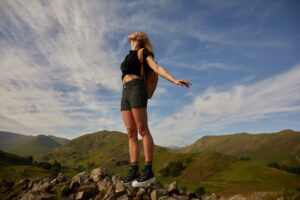These urban escapes promise a taste of the countryside.
When most people think of gritty Berlin, they picture an ultra-urban playground of (mainly) indoor pleasures: techno clubs, chilled-out bars, and edgy art galleries for which the city has a reputation. And while that’s all certainly a draw, 40 percent of Germany’s sprawling capital is parks, forests, and bodies of water—in fact, Berlin and the surrounding state of Brandenburg are home to more than 3,000 lakes. When Berliners want to escape their gray-leaning environs—and the often-oppressive summer heat—they have their pick of serene (or even some party-focused) spots for swimming or socializing, forest hikes, and massive gardens to laze in. Best of all, many of these places are accessible by public transit or bike; plentiful car-share options can also get you where you need to go.
While living in Berlin for the past five years, I’ve been lucky enough to explore these areas, uncovering fantastic nature both within and just outside of the city. Here are nine standout outdoors activities in Berlin for mixing up a visit to this urban destination in spring, summer, or fall.
Urban lakes

Schlachtensee
Best for: Fitness gurus and food lovers
Know before you go: Next to the lake, you’ll find a fine playground and stationary tractor that makes Schlachtensee ideal for families with young kids.
When Berlin urbanites want to feel like they’ve left the city without actually leaving, they head to this lovely forest lake in southwest Berlin’s Steglitz-Zehlendorf district, accessible by S-bahn, bus, or bike. Though it has few strictly sandy sections, this pretty tree-lined body of water promises plenty of calm, grassy areas to read or soak up some rays, and an easy 4.3-mile lakeside path for relaxing walks or runs in the surrounding Grunewald Forest; you can also swim in the lake. When hunger strikes, the adjacent Alte Fischerhütte (Fisherman’s Hut)—housed in a former inn built in 1723—dishes out tasty fish, including zander (pike perch) straight from the lake. Or, grab a pint and people-watch at the beer garden, which serves up mulled wine and hot chocolate in the colder months.
Plötzensee
Best for: Families and sun bathers
Know before you go: There’s not a lot of shade, so bring your own umbrella or rent one on the beach. There’s also a small nude beach, a common inclusion on Berlin lakes. Beach entrance costs €8.50 (kids age four and under can go for free), with one drink included.
Where Berliners go when they want something convenient and lively, Plötzensee—part of the Volkspark Rehberge Nature Reserve smack in the middle of the Wedding Kiez (neighborhood)—is the most centrally located of Berlin’s lakes, and easily accessible by tram or bike. Plötzensee’s 161,000-square-foot sandy beach has the key things city dwellers need for a fun day out: Aperol spritzes for the adults, a playground and waterslides for the kids, and pedal boats and beach volleyball for young and old alike. But there’s also history here; between 1933 and 1945, nearly 3,000 people were killed by Nazis at this site—and a memorial to victims offers a place of quiet remembrance for visitors to pay their respects.
Wannsee

Best for: Urban types who want to feel like they’re on an ocean beach
Know before you go: There’s a playground for the young ones and—since this is Germany—a nude sunbathing section. Beach entrance costs €5.50; kids under age five visit for free.
This bustling lake in Berlin’s southwest (Steglitz-Zehlendorf) bills itself as one of Europe’s biggest outdoor swimming areas on an inland body of water; you might have caught Wannsee’s cameo in the 2020 Netflix hit “Unorthodox.” As with everything in Berlin, history isn’t far off, either: Across from the beach, on the lake’s western shores is the House of the Wannsee Conference, where the Nazis formulated the “Final Solution.”
Today, Wannsee is arguably Berlin’s best swimming lake in its still and shallow (and brisk) waters—and carving out a spot on the mile-long beach, with sand imported from Germany’s Baltic Sea; renting a traditional covered wicker sun chair (called a strandkorb); and sipping a chilled glass of rosé from the beach bar makes Wannsee a perfect hangout on a sweaty Berlin summer’s day.
Flughafensee
Best for: Picnics by the lake and long walks through the woods
Know before you go: Flughafensee has no food or drink options, so be sure to bring your own—but plenty of trees offer shade, so you can skip lugging an umbrella.
Berlin’s deepest lake (113-feet deep, in fact), close to once-beloved-but-now-defunct Tegel Airport in northern Berlin’s Reinickendorf Kiez, was known for spotting low-flying planes while swimming. But since Tegel closed in late 2020, this peaceful artificial lake surrounded by forest now makes for a less-noisy spot for a swim and stroll. Gravel mining in the area between 1953 to 1978 resulted in the formation of Flughafensee, which today includes a sandy beach on its north shore and a bird sanctuary on its south shore.
An island escape

Pfaueninsel (Peacock Island)
Best for: Romantics and walkers
Know before you go: The ferry costs €12.00 roundtrip.
Simply getting to the UNESCO World Heritage site of Peacock Island in the western edges of Berlin adds to its charm, as it requires a short ferry across the Havel River. At the end of the 18th century, King Frederick William II and his wife Wilhelmine Encke modeled this 166-acre natural reserve after South Pacific islands, bringing in exotic plants, trees, and animals—including, yes, live peacocks. In 1842, most animals were transferred to the brand-new Berlin Zoo, though the Pfaueninsel peacocks remained. Today, you can not only see the free-roaming fowl during an easy hike on the island’s footpaths, but also enjoy Berlin’s oldest rose gardens, planted in 1821, and admire the original royal buildings, including a summer palace and dairy.
Immersive gardens

Berlin Wall Trail (Berliner Mauerweg)
Best for: Anyone who wants to learn more about the fascinating events that have shaped modern-day Berlin
Know before you go: The trail is split into 14 sections, each between four and 13 miles, so you can walk or bike as little or as long as you want.
For a hike or bike ride that’s truly unique to Berlin, the 100-mile Berlin Wall Trail runs along the former roads used by East German border troops. Along the way, you’ll pass by traces of the Berlin Wall along with info signs that relate stories about Berlin’s history, including its division into east and west and the construction and collapse of the Berlin Wall. The trail also includes photos of historical events that occurred at those very sites.
Gardens of the World (Gärten der Welt)
Best for: Budding horticulturists and their nature-starved parents
Know before you go: Entry costs €7.00 in summer, €4.00 in winter, and free for children age five and under.
To see plants and flowers from all over the globe, you only have to travel to the far eastern reaches of Berlin—which, admittedly, can still seem quite far in a city so spread out. Gardens of the World, in the city’s northeast Marzahn neighborhood, houses 10 beautifully landscaped gardens with international themes including Japanese, Chinese, and Balinese, along with Christian, Jewish, and Islamic gardens. Kids will love the garden maze, modeled after the one at London’s Hampton Court, as well as the water playground with a gigantic climbable whale. Berlin’s only cable car lets you glimpse all the greenery from on-high.
Central Berlin’s vibrant river scene
Badeschiff (Bathing Ship)
Best for: A bar scene with swimming on offer
Know before you go: Opening dates depend on the weather, but generally run from May to September.
For a truly urban option, you can’t beat this 100-foot-long pool constructed from a barge anchored into the Spree River, in Alt-Treptow. Though it’s more about the scene than the swimming, the Badeschiff makes the perfect place to go for a dip and hang out on the sandy patio with a cocktail in hand. It’s extremely popular with locals and tourists alike; book a two-hour slot online (for €8.00) up to four days beforehand.
Holzmarkt 25
Best for: People of all ages who want to experience alternative Berlin at its best
Know before you go: Many of the food and drink venues are cash-only, so make sure to bring some bills with you.
Also along the banks of the Spree River, Berlin’s largest sustainable urban development project has a ramshackle vibe. Berliners flock to Holzmarkt on summer afternoons to get their fill of pizza and beer while perching on the river’s edge and chilling to electronic beats. Though adults-only club Kater Blau also calls Holzmarkt 25 home, families are encouraged to bring kids of all ages to the grounds; there’s even an expansive playground. Keep an eye out for special events on-site, from vintage popups to wine fairs to literary readings.
Source: cntraveler









